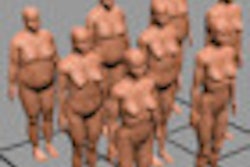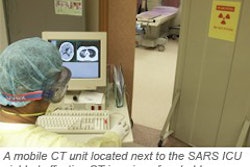Splashing a bit of cold water on the coronary calcium scanning beast, researchers from the University of Iowa have concluded that CT attenuation varies significantly depending on the subject's body mass, a finding that casts doubt on the accuracy of phantom-based scanning measurements. The solution, they suggest, is to perform a separate phantom data analysis to establish an accurate baseline for every coronary calcium exam.
Notwithstanding the growing popularity of CT assessment of coronary calcium as an indicator of atherosclerotic disease, an important question has gone unanswered, wrote Dr. William Stanford, Trudy L. Burns, Ph.D., and colleagues in this month's issue of Radiology.
"What is the effect of incorporation of phantom measurements on calcium scores?" the authors asked. "This question is important in that the use of phantoms has the potential to minimize calcium-score variability, especially among individuals of different body habitus. The purpose of this study was to determine whether differences in body mass index (BMI) and image section levels representing the proximal through the distal sections of the heart are associated with attenuation differences in images of calcium phantoms during ...CT imaging of study subjects" (Radiology, January 2004, Vol. 230:1, pp. 198-205).
The experiment required a complicated setup in which the radiation beams of an electron-beam CT scanner were directed upward through a phantom, a mattress packed with three cylinders of calcium hydroxyapatite. The beams continued through the 691 subjects (400 women and 291 men aged 29-43), whose body habitus had been carefully measured, finally activating detectors in the gantry above the patient.
Phantom cylinders 1-3 contained calcium hydroxyapatite concentrations of 0 mg/mL, 75 mg/mL, and 150 mg/mL, respectively. Imaging was performed with 100-msec acquisitions triggered at 80% of the R-R interval, at 130 kV, 630 mAs, and in 40 contiguous sections of 3-mm thickness each. Before the subjects got involved, another set of phantoms -- tissue-equivalent body phantoms in three sizes on top of the loaded mattress -- were to determine baseline attenuation values used as a reference standard.
The subjects were divided into four sex-specific BMI quartiles. The analysis measured attenuation for each of the three phantoms inside the mattress for each of four different image section levels through the heart, beginning with the section where the left main and/or left anterior descending artery was visualized. Only phantom data, not coronary calcium data, was used in the analysis.
According to the results, phantom-cylinder attenuation in both men and women differed significantly from the reference-standard values, and was generally associated with both section level (p<0.005) and BMI quartile (p<0.0025-0.05). In men, the measured mean attenuation value for phantom 1 was significantly higher at the first (0) and third (30) section levels (p<0.005); while for phantom 2 it was significantly lower at each section level (p<0.005); and for phantom 3 it was significantly lower at the first (0) and second (10) section levels (p<0.005), and significantly higher at the fourth (30) (p<0.005) level compared to the reference standard.
There was generally less attenuation distally (and less deviation from the reference standard) compared with the more proximal sections of the heart. Still, there was considerable variability in mean attenuation among subjects, as indicated by the phantom level.
A two-factor repeated measures ANOVA model was used to assess attenuation differences by section level, and the interaction effect between section level and phantom was significant for both men and women, Stanford and colleagues wrote. In addition, scanning was repeated in 279/671 subjects in order to verify the reproducibility of mean phantom attenuation values, and the similarity was estimated by estimating intraclass correlation coefficients (p<0.0001). The results suggested that repeat scans obtained on the same day are reproducible. The association between BMI and mean attenuation was also assessed.
Parameter estimates of the attenuation value that would be read as 130 HU on a calcium scan found that, taking the change in attenuation into account, a voxel read as 130 HU actually represented 140.3 HU, according to one example.
"In general, the estimated mean attenuation increased (i.e., the means were further from the reference standard) as the BMI quartile increased (reflecting a greater degree of attenuation with greater BMI), and decreased (i.e., the means more closely approximated the reference standard values) as the section levels progressed further distally (reflecting less attenuation in the distal portion of the heart)," the authors wrote. "In both men and women, the pattern of increasing estimated mean attenuation with increasing BMI quartile held for each section level. The estimated mean attenuation value was also higher in men than in women, reflecting greater attenuation in men."
This association between phantom measurements and body mass indicates that subthreshold lesions (<130 HU) may reach the threshold level if phantom data are incorporated into the measurement process, the authors wrote. As a result, total calcium scores and volumes may change.
Examining the possibility of lower thresholds, the group further estimated subject and section-specific thresholds corresponding to a measured 130 HU, and came up with an actual attenuation of 120.3.
Because of these attenuation differences between the proximal and distal portions of the heart, a post-hoc phantom data adjustment, as used by Watson et al, might not be sufficient, the authors stated. On the other hand, a subject- and section-specific threshold applied during the scanning process might enable a lesion that did not meet the 130-HU minimum to be identified rather than missed.
Differences in attenuation related to BMI and image section level appear to have a significant effect on current calcium-scoring methods, though it is unclear whether the observed changes result from the presence of liver tissue or increased tissue thickness at the diaphragm, or increased scatter, the authors wrote.
"There appears to be a need for use of a phantom for value adjustments in longitudinal and multicenter investigations," they concluded.
By Eric BarnesAuntMinnie.com staff writer
January 28, 2004
Related Reading
Calcium score improves cardiac risk assessment with standard method, January 15, 2004
Sixteen-slice CTA scanning makes everything better, January 5, 2004
Calcium-scoring methods study says it's all good, September 10, 2003
Coronary calcium scan gains ground as prognostic tool, August 6, 2003
Calcium mass measures coronary calcium best, June 17, 2003
New techniques boost accuracy of coronary calcium assessment, March 5, 2003
Thin-collimation MDCT identifies more coronary calcium, December 18, 2002
Copyright © 2004 AuntMinnie.com



















